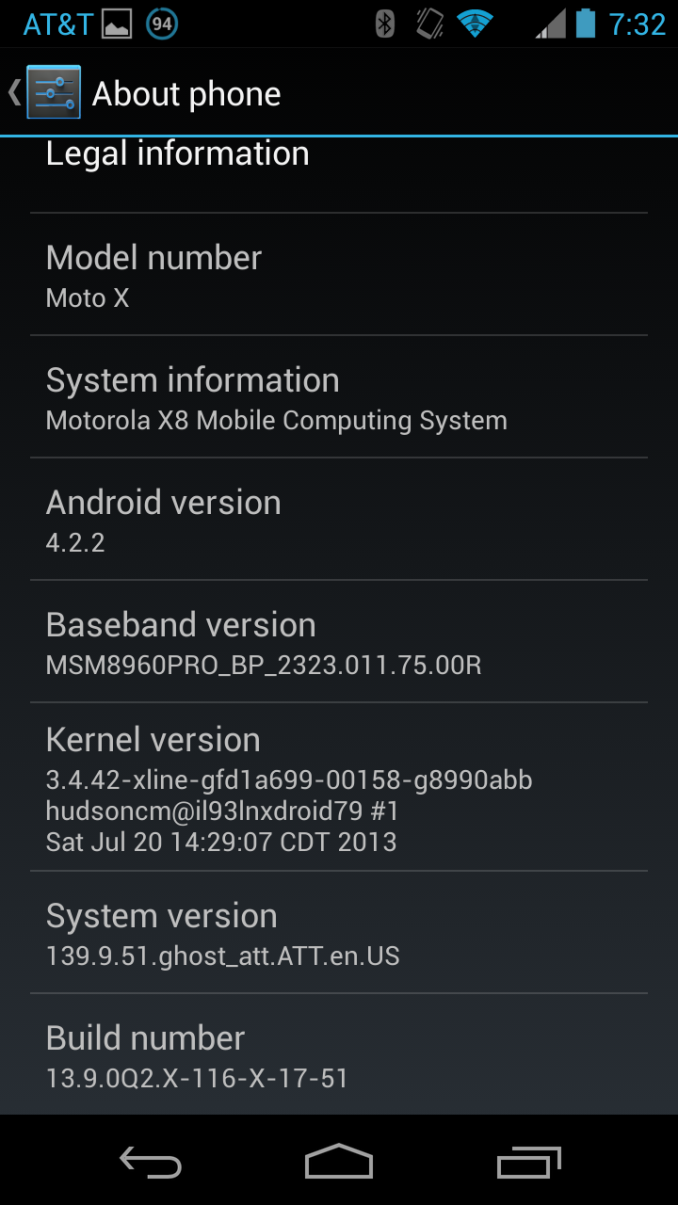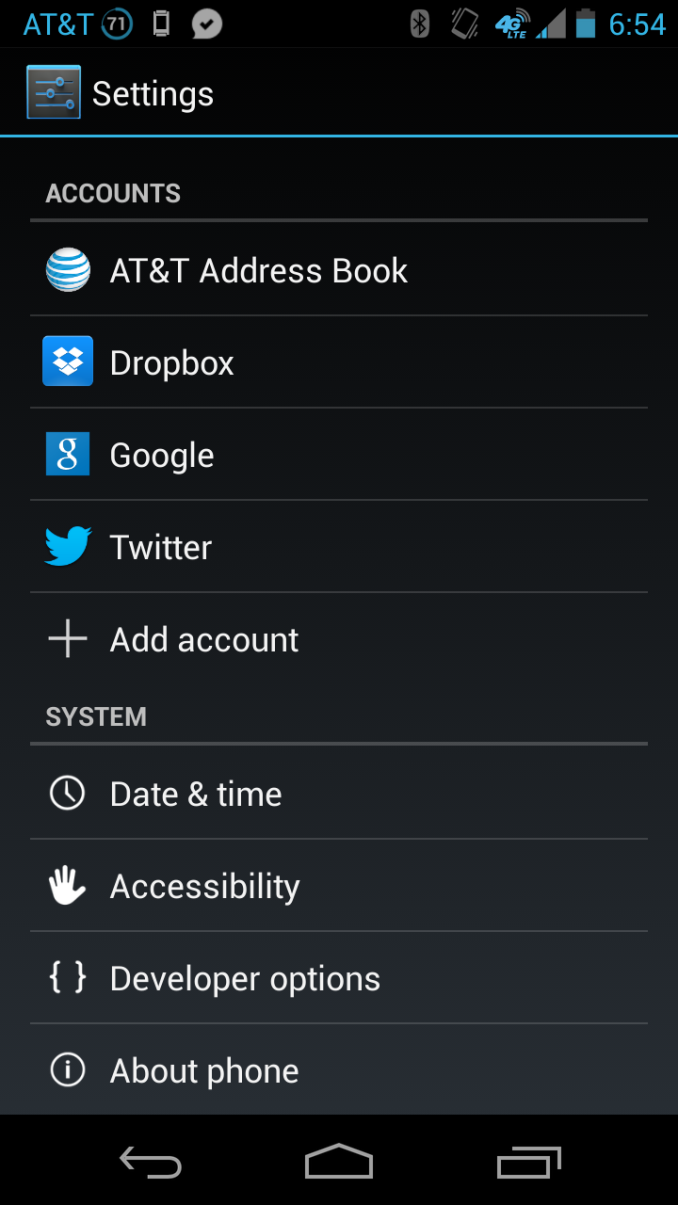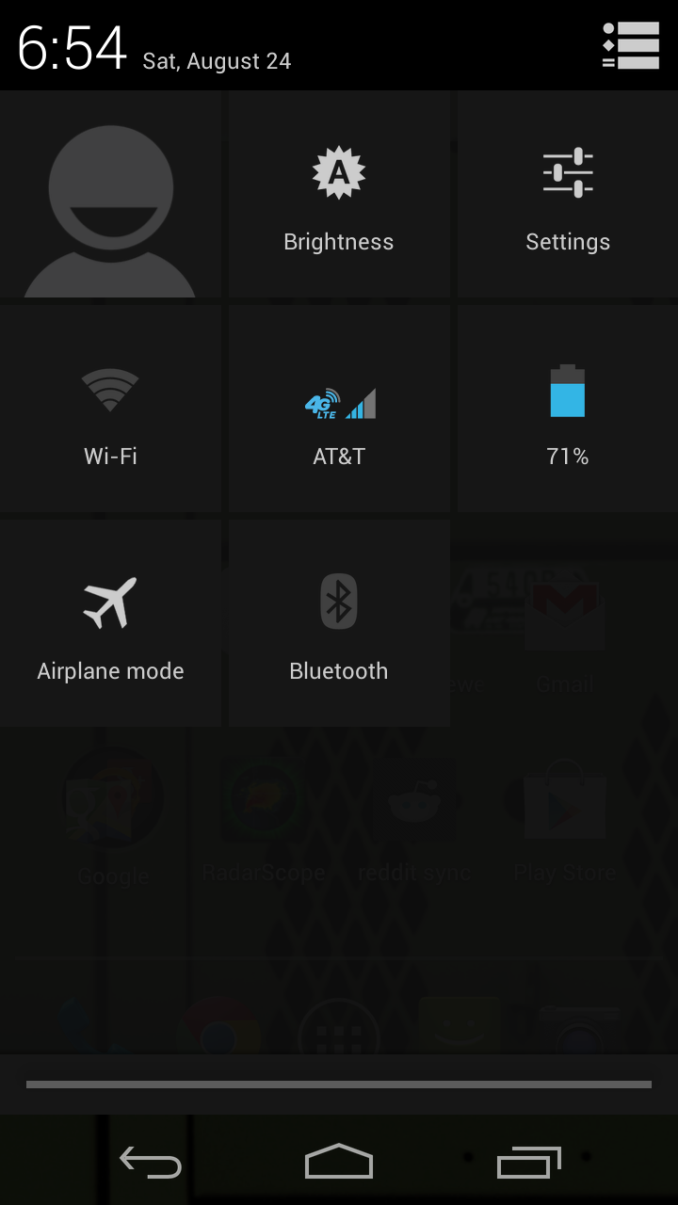Moto X Review
by Brian Klug on August 26, 2013 1:30 PM EST- Posted in
- Smartphones
- Qualcomm
- MSM8960
- Motorola
- Android
- Mobile
- Android 4.2
- Moto X
Somewhat Stock Android
One of the first things that changed for Motorola under its new Google ownership was the final nail through the coffin for Motoblur, with OTA updates for some of its handsets gradually scaling back customized features in favor of stock ones. I joked with Anand that Google paid $12.5 billion for Motorola just to kill the beast that was Motoblur. Truth be told the presence of largely-stock Android 4.x UI is perhaps one of the best qualities of the Moto X.
ro.build.version.full=Blur_Version.139.9.51.ghost_att.ATT.en.US
The Moto X at launch runs Android 4.2.2, which isn’t quite bleeding edge Android, but close. This is essentially an intentional side effect of the Google / Motorola firewalling that we’ve been told is in place. I’m not entirely surprised, but I had hoped the Moto X would differentiate itself by somehow launching with 4.3 considering other handset partners had the Jelly Bean MR2 (4.3) update a while ago, clearly Motorola should’ve as well. I know that Qualcomm had the BSP (Board Support Package) for 4.3 ready for MSM8960Pro at the same time as it did APQ8064, so I can’t think of any technical reason. Again I’d wager Moto X launching with 4.2.2 is entirely political, to say nothing of the usual operator testing nonsense in the USA.
Anyhow the homescreens (widget panels), launcher, settings menu, notification shade, dialer, and default applications are basically unadulterated Android. I say largely unadulterated because to say that the Moto X is entirely stock is still not quite true – there’s the operator name in the top left of the notification bar all the time, and the branded network status indicator (the cartoonish looking AT&T “4G” and “4G LTE” logos) on my AT&T unit. Unnervingly, the network status logo and bars are also a different shade of blue than the battery and time icons adjacent to it.
There’s also AT&T address book preloaded which cannot be removed, which is a huge annoyance. There’s also a provisioning check for bluetooth and WiFi tethering, another indication of an operator-touched device. There’s also AT&T my Wireless and AT&T’s visual voicemail app loaded, but those are pretty understandable.
The Moto X also has a few UI changes that definitely aren't stock. The status bar has different spacing for the cellular and WiFi indicator logos which carries over as a result of Blur (the spacing issue is just the "4G LTE" or similar status logo disappearing when on WiFi). Also the on-screen android buttons sometimes appear transparent, showing what's under, which definitely isn't a stock implementation.
My definition of stock is just that, totally stock – no branded logos, operator names everywhere, or any preloaded apps. Truth be told the Moto X isn’t stock, it just has the stock UI on top of a relatively standard Motorola software build, but it does have a heck of a lot less of the operator preload crapware that normally shows up on Android phones sold with a subsidy these days. Android’s visual style is now mature and appealing enough that it really doesn’t need customization or modification to look good, rather it just needs to be left alone as much as is politically possible. If there’s one thing the Moto X does that every other handset maker should take to heart, it’s exactly that.
If you’re on a wireless operator that can’t work with the newest Nexus phone or Google Play edition devices (like the CDMA ones in the USA – Verizon, Sprint, US Cellular), the Moto X might be the closest you can get to stock, even if it technically isn’t completely so. I suspect this will attract a lot of enthusiasts who are on other operators for their own reasons, even if the longer term solution really should be to vote with your wallet and move to an operator that’s open and compatible with those devices.














105 Comments
View All Comments
cheinonen - Tuesday, August 27, 2013 - link
4K is a marketing term thanks to Sony and everyone else. In the actual definition, 4K doesn't have a set aspect ratio. A film mastered at 4K is 4096 pixels wide, and the height is totally dependent on the aspect ratio. If it is flat, then it's 4096/1.85 pixels high. If it is scope, it's 4096/2.39 pixels high.Sony, LG, Samsung and everyone else are using 4K to mean 3840x2160 pixels for the home. UltraHD is the technical name now (with Rec. 2020) but that was finalized after the 4K horse had already left the barn.
Impulses - Tuesday, August 27, 2013 - link
Kind of ironic, I bet UltraHD sounds catchier or at least more descriptive to the layman... 4K's definitely spreading fast tho.rcpinheiro - Tuesday, August 27, 2013 - link
You're right, marketing teams are using "4K" incorrectly but at least here in AnandTech I expected writers to use standard names correctly.4K is a standard created by Digital Cinema Initiative, it uses JPEG2000 compression and bitrates upto 250Mbps.
(I agree with use Impulses, for the layperson "Ultra HD" sounds better than the techy term "4K")
Krysto - Tuesday, August 27, 2013 - link
It is a marketing term - an unfortunate one. Because I don't want them to ruin the ratios when they get to that resolution. They should keep the UHD resolution to scale perfectly from 1080p (4x the pixels). If some OEM's decide that to have "real 4k" they need to make the resolution 4kx2k, that would really SUCK!.mike55 - Monday, August 26, 2013 - link
Brian, what are your reasons for preferring some LCDs over Samsung's OLED panels?Doh! - Monday, August 26, 2013 - link
I could tell you couple reasons as a long time user of Sammy's OLED panel in my phone but I'm not Brian. Having said that, burn-in is one of the issues for many OLED panels.Impulses - Tuesday, August 27, 2013 - link
For me, the over saturated colors IMO, not the best for viewing photos, and I've started to view a lot of non-smartphone photos on my phone now that my camera has Wifi/NFC (most current gen Panasonic/Sony do, even Canon's newest DSLR, the 70D).mike55 - Tuesday, August 27, 2013 - link
It's unfortunate that a lot of manufactures seem to disregard the sRGB color space when it comes to implementing OLED panels in their devices. I'm not sure I would've bought my GS4 if it weren't for the "movie" display mode that gets it somewhat close to the sRGB gamut.comomolo - Tuesday, August 27, 2013 - link
I'm not Brian either, but I don't care too much about color accuracy on a phone. I do care about something the N9 invented and amazingly nobody else still copied it yet: permanent display of the time and notification icons. That can't be done efficiently with an LCD and its so useful I simply can't understand it took that long to come to Android. Even this MotoX isn't implementing it fully. You still can't just take a look at the phone on the table and know the time or if some new message is in, if there's a missed call or text, etc.I haven't seen a single burned pixel on an AMOLED screen (been using Samsung phones for a while, and lots of friends too). Regarding color accuracy, I don't believe the technology itself is responsible for that, but factory calibration. Android might/should allow for user calibration (the same we do with monitors) and make this a moot point.
Heartdisease - Wednesday, August 28, 2013 - link
Well that's strange. My Galaxy Nexus has had burn in for quite awhile and it is getting more pronounced. Turn any amoled 180* from your normal orientation and look where the on screen buttons were. If you don't see it on the rest of the screen your blind.